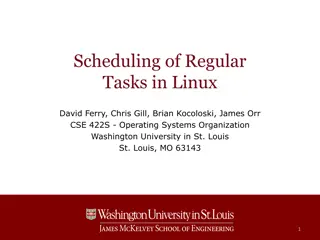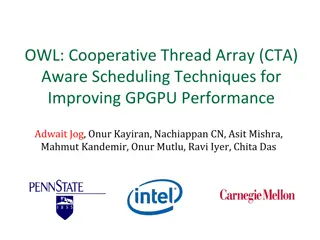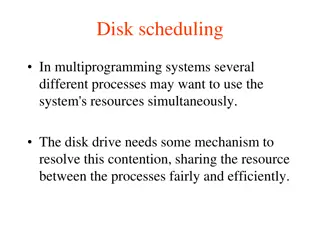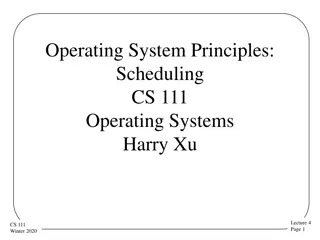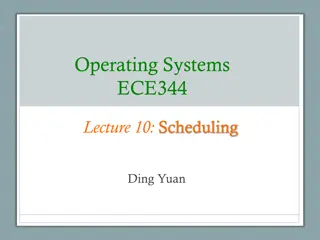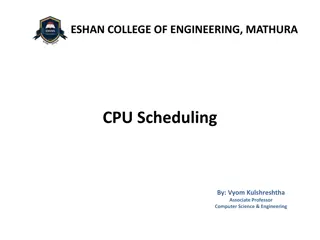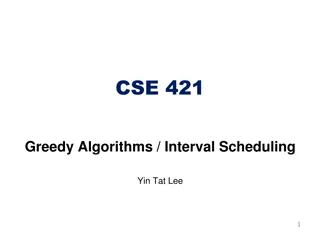
Understanding Synchronization and Scheduling in Multicore CPUs
Explore the challenges of concurrent programming in multicore CPUs, including synchronization issues and the need for locks to prevent overlapping instruction sequences. Learn about real-time scheduling, dependencies, and the importance of synchronization in kernel operations.
Download Presentation

Please find below an Image/Link to download the presentation.
The content on the website is provided AS IS for your information and personal use only. It may not be sold, licensed, or shared on other websites without obtaining consent from the author. If you encounter any issues during the download, it is possible that the publisher has removed the file from their server.
You are allowed to download the files provided on this website for personal or commercial use, subject to the condition that they are used lawfully. All files are the property of their respective owners.
The content on the website is provided AS IS for your information and personal use only. It may not be sold, licensed, or shared on other websites without obtaining consent from the author.
E N D
Presentation Transcript
Chapter 5: Synchronization and Scheduling Smruti R. Sarangi IIT Delhi (c) Smruti R. Sarangi, 2023 1
Outline of this Chapter Real Time Scheduling with Dependences Scheduling Synchronization in the Kernel Synchronization Basics (User Space) (c) Smruti R. Sarangi, 2023 2
Consider a Multicore CPU Do something as simple as count++ Assume there are multiple threads. Each line corresponds to one line of assembly code. count is a global variable stored in memory and t1 is a register. Will this work correctly? t1 = count t1 = t1 + 1 count = t1 (c) Smruti R. Sarangi, 2023 3
Consider 2 Threads count = 0 Thread 2 Thread 1 t1 = count t1 = t1 + 1 count = t1 t2 = count t2 = t2 + 1 count = t2 The delay between any two instructions can be indefinite What can this cause? (c) Smruti R. Sarangi, 2023 4
Problematic Executions count = 0 There is no synchronization between threads here Arbitrary overlaps are possible t1 = count t2 = count t1 = t1 + 1 t2 = t2 + 1 count = t1 count = 1 count = t2 count = 1 Should be 2 (c) Smruti R. Sarangi, 2023 5
Concurrently incrementing count is hard What is the main issue? The instruction sequences are overlapping. We need synchronization. Acquire a lock. Only one thread can get in t1 = count t1 = t1 + 1 count = t1 Unlock. (c) Smruti R. Sarangi, 2023 6
What will the code look with locks Thread 1 Thread 2 t1 = count t1 = t1 + 1 count = t1 t2 = count t2 = t2 + 1 count = t2 (c) Smruti R. Sarangi, 2023 7
What is a lock anyway? Implementation of a lock You lock a memory address A Test if the memory address contains a 0, else loop Atomically set the value to 1 Some other thread was successful in setting the location to 1 If successful (c) Smruti R. Sarangi, 2023 8
Unlocking Set the contents of the location to 0 Critical section (c) Smruti R. Sarangi, 2023 9
Notion of Data Races Why does the version of the code without locks not work in the first place? We have a data race Conflicting accesses by two threads At least one of the threads writes to the shared variable Concurrent accesses Both the accesses are happening roughly at the same time. There is a more precise definition that uses the notion of happens-before relationships and lock-unlock relationships. Let A and B be memory access events. A happens before B, if A is a memory access in a critical section, then its lock is released and reacquired by the critical section that B is a part of. Concurrent accesses do not have any happens- before relationships between them. (c) Smruti R. Sarangi, 2023 10
Properly Labeled Programs Ensure that all the shared variables (shared across threads) are always accessed in the context of a critical section and there are no data races. This program has a data race. Lock (X) Lock (Y) Access locations A, B, and C Access locations D, E, and C A shared variable always has to be protected by the same lock. (c) Smruti R. Sarangi, 2023 11
Locks can lead to deadlocks .... Thread 1 Thread 2 Lock Y Lock X Lock X Lock Y (c) Smruti R. Sarangi, 2023 12
Four Conditions for a Deadlock Hold and Wait A thread is holding on to a lock and waiting for another one. No preemption The lock cannot be taken away from a thread. Mutual exclusion A lock can be held by only a single thread. Circular wait Cyclic dependence between threads (c) Smruti R. Sarangi, 2023 13
Solutions for Preventing Deadlocks Hold and Wait Acquire all the locks at once, or acquire none at all. No preemption Resources can be taken away from threads. Mutual exclusion This is a basic property of a lock. This cannot be tampered with. Circular wait Design a protocol such that circular dependences will never form. 14 (c) Smruti R. Sarangi, 2023
Dining Philosophers Problem A philosopher needs to pick up both the forks to eat. He can pick up only one fork at a time. Avoid deadlocks. Ans: In general, pick the left fork first. Break the symmetry for one philosopher. (c) Smruti R. Sarangi, 2023 15
Livelocks, Deadlocks, and Starvation Deadlocks All the threads are waiting on each other. Starvation A thread waits indefinitely to get access to the resource. Starvation freedom implies deadlock freedom (not the other way). Livelocks Threads keep executing instructions but nothing productive gets done. (c) Smruti R. Sarangi, 2023 16
Examples (c) Smruti R. Sarangi, 2023 17
int main(void) #include<stdio.h> { #include<pthread.h> int errcode, i = 0; int *ptr; #include<stdlib.h> for (i=0; i < 2; i++) #include<unistd.h> { pthread_t tid[2]; ptr = (int *) malloc (sizeof(int)); int counter; *ptr = i; errcode = pthread_create(&(tid[i]), NULL, void* func(void *arg) &func, ptr); { if (errcode) int *ptr = (int *) arg; printf("Error in creating pthreads \n"); printf("Thread %d \n", *ptr); } } pthread_join(tid[0], NULL); pthread_join(tid[1], NULL); } gcc <prog_name> -lpthread (c) Smruti R. Sarangi, 2023 18
More complicated version of this example The return value of the func function can be collected by the pthread_join call The second argument is a pointer to a pointer. It is populated with the pointer that was returned by the func function. [Download the code from the website of the book] pexaug.c (c) Smruti R. Sarangi, 2023 19
The same code with locks for incrementing a shared variable int count = 0; pthread_mutex_t cntlock; void* func(void *arg) { pthread_mutex_lock(&cntlock); count++; pthread_mutex_unlock(&cntlock); } int main () { retval = pthread_mutex_init (&cntlock, NULL); ... ... printf ( The final value of counter is %d \n , counter); } (c) Smruti R. Sarangi, 2023 20
Code without locks (lock-free programming) #include <stdatomic.h> atomic_int count = 0; void * fetch_and_increment (void *arg) { atomic_fetch_add (&count, 1); } Also known as non-blocking algorithms (c) Smruti R. Sarangi, 2023 21
Same Example with Compare_and_Exchange Increment using the compare_and_swap primitive atomic_int count = 0; #define CAS atomic_compare_exchange_strong void* fetch_and_increment (void *arg){ int oldval, newval; do { oldval = atomic_load (&count); newval = oldval + 1; printf ( old = %d, new = %d \n , oldval, newval); } while (! CAS (&count, &oldval, newval)); (c) Smruti R. Sarangi, 2023 22
Output old = 0, new = 1 old = 0, new = 1 old = 1, new = 2 The final value of count is 2 In this case, there is the possibility of many failed attempts at performing the CAS. If threads are allowed to call this function repeatedly, then it is possible that a few threads may starve forever. (c) Smruti R. Sarangi, 2023 23
Theory of Non-Blocking Algorithms (c) Smruti R. Sarangi, 2023 24
Correctness Every read or write operation has the following attributes: start time end time completion time In the case of a read operation 1. The start time is when the load operation enters the pipeline 2. The end time is when the data (to be read) reaches the load-store unit 3. The completion time is when the data is read (at the cache or memory storage unit) start time < completion time < end time (c) Smruti R. Sarangi, 2023 25
What about Write Operations? Write CPU Delay Start time Time at which the store operation enters the pipeline End time Time when the store operation is sent to the memory system (at this point the instruction also leaves the pipeline) Completion time Time at which the write takes effect (could be delayed) Write buffer L1 Cache start time < end time < completion time (c) Smruti R. Sarangi, 2023 26
Let us generalize Reads and writes are the simplest of operations We can define many concurrent objects that can be accessed simultaneously by many threads: concurrent queue concurrent stack concurrent linked list . Every operation has a start time, end time and a completion time An atomic operation appears to complete instantaneously at the completion time. The completion time itself may not be known. Whether the actual operation completed at that time or not is irrelevant. We just need to show that it theoretically exists. (c) Smruti R. Sarangi, 2023 27
An execution involving a concurrent queue enq: 3 deq: 3 deq: 4 deq: 2 Thread 1 enq: 1 enq: 4 Thread 2 deq: 1 enq: 5 enq: 2 Thread 3 Hypothetical sequential order {5,4} {5} {} {4} {3} {} {2} {1} {3,1} Completion times (c) Smruti R. Sarangi, 2023 28
Parallel Execution Sequential Execution The example on the previous slide shows a parallel execution If we arrange the operations by their completion times, we have a sequential execution We say that both are equivalent ( ) The sequential execution must be: Legal Respect the semantics of the object (in this case a queue) Sequential semantics of a queue FIFO order (c) Smruti R. Sarangi, 2023 29
Notion of Memory Models For every operation, the completion time is between the start time and end time. Linearizable Per-thread order is respected. If operationsA and B are issued by the same thread and A ends before B starts in the parallel execution, then A appears before B in the equivalent sequential order. The execution is atomic. Sequentially Consistent Operations issued by the same thread to different addresses can be reordered in the equivalent sequential order. There can be different reordering rules and Weakly Consistent (c) Smruti R. Sarangi, 2023 atomicity can also be relaxed. 30
Linearizability The operation needs to be atomic It needs to appear to execute instantaneously (single instant of time) Either the entire operation executes, or it appears to not have executed at all Atomicity vs Linearizability Atomicity basically says that the entire operation (like enqueue/dequeue) appears to execute at any one instant of time However, it does not say that this execution point needs to lie between the start and end of the operation This is where we have linearizability a stronger criterion It says that if the end time of an operation is before the start time of another operation, then their execution (linearization) points follow the same order (c) Smruti R. Sarangi, 2023 31
Another Look at Linearizability Linearization point Start End The linearization point needs to lie between the start and end It corresponds to a specific instruction within the function Proving that a certain instruction is a linearization point is a very well established area of research, and it is often quite difficult to do so This makes it quite difficult to write such programs (c) Smruti R. Sarangi, 2023 32
Sequential Consistency The start and end times are not known to us Nor are they relevant here. What we have instead are sequences of operations (initiated by each thread) Arrange them in a global sequential order such that the outcomes are legal. A3 A1 A2 A1 A2 B1 B2 B3 B1 B2 B3 A3 C2 C1 C1 C2 (c) Smruti R. Sarangi, 2023 33
Some Concepts w.r.t. Memory Models Thread 1 Thread 2 x = 1 t1 = y y = 1 t2 = x Consider two threads that access two global variables: x and y They are initialized to 0 t1 and t2 are temporary variables stored in registers Is the outcome <t1,t2> = <0,0> possible? If you assume sequential consistency or linearizability. (c) Smruti R. Sarangi, 2023 34
Non-Sequentially Consistent Machines Owing to performance reasons, all modern machines will allow this behavior. Their memory models are not sequentially consistent. How do you write parallel code then? Theorem: Data-race-free programs have SC executions on all machines Accesses to global atomic variables can have data races concurrent and conflicting accesses. Avoid data races. How? Use fences and access shared variables in critical sections A fence or a memory barrier instruction forces sequentiality (synch. between accesses) All instructions before it in program order need to complete before it completes. Before it completes, no instruction after it (in program order) can complete For all accesses to regular (non-atomic) variables, just wrap them in critical sections. A lock or unlock operation (around a critical section) needs to have a fence. (c) Smruti R. Sarangi, 2023 35
Data Races, Fences and Locks Locks use atomic operations Many atomic operations have built-in fences We can also add fences explicitly The lock-unlock operation and the fences ensure an ordering between conflicting accesses to the same shared variable. This eliminates data races. x = 1 Unlock + fence Lock + fence Enjoy SC x = 2 (c) Smruti R. Sarangi, 2023 36
Progress Guarantees (c) Smruti R. Sarangi, 2023 37
Obstruction-free vs Lock-free vs Wait-free Assuming a thread that is holding a lock goes off to sleep or is swapped out Then this means that the rest of the threads will not be able to make any progress This is unfair. We thus need algorithms with better progress guarantees If n-1 threads stop, then the nththread can finish in a bounded number of steps Obstruction-free At any point of time, there is at least one thread that is going to complete in a bounded number of steps. Lock-free Wait-free All threads complete within a bounded number of steps. (c) Smruti R. Sarangi, 2023 38
What does all of this mean? In an obstruction-free algorithm, no thread can hold a lock and go off to sleep It should be possible to finish one thread s operation by putting the rest of the threads to sleep all the time Using locks is thus precluded unless locks can be released on a context switch Lock-free algorithms are more difficult to write They are fast in practice They guarantee system wide progress, but individual threads can starve Use wait-free algorithms They are slower than lock-free algorithms in practice but have much stronger progress guarantees. (c) Smruti R. Sarangi, 2023 39
Obstruction free Lock free Wait free (c) Smruti R. Sarangi, 2023 40
Semaphores and Reader-Writer Locks (c) Smruti R. Sarangi, 2023 41
Semaphores count Semaphore waiting queue A semaphore maintains a count Plus, a kernel-level wait queue Execute atomically if (count == 0) wait(); else count --; sem_wait (c) Smruti R. Sarangi, 2023 42
Semaphores II if ( (count == 0) && process_waiting()) wake_from_wait_queue(); else count ++; sem_post A binary semaphore (Boolean count) is equivalent to a lock A non-binary semaphore uses a count larger than 1 Quite useful while implementing a bounded queue (c) Smruti R. Sarangi, 2023 43
Reader-Writer Lock Key Idea: Either one thread writes or multiple threads read Read Read-write lock Read lock Write Have two modes: 1. A write mode that allows a single writer 2. A read mode that allows multiple readers but no writer Switch between them (c) Smruti R. Sarangi, 2023 44
Read and Write Locks Basic Idea: void get_write_lock(){ LOCK(__rwlock); } void release_write_lock(){ UNLOCK(__rwlock); } void get_read_lock(){ LOCK(__rdlock); if (readers == 0) LOCK(__rwlock); readers++; UNLOCK (__rdlock); } void release_read_lock(){ The enqueue and dequeue function need the read_write lock: rwlock Writing always involves reading LOCK(__rdlock); readers--; if (readers == 0) UNLOCK (__rwlock); For acquiring the read lock, we need to ensure that there are no current writers. Hence, acquire rwlock if there are no other readers UNLOCK(__rdlock); } Fairness is an issue Update the number of readers, by locking the read lock (c) Smruti R. Sarangi, 2023 45
Queues (c) Smruti R. Sarangi, 2023 46
Case of Bounded Queues Consumers Producers The bounded queue is an important data structure It is used in a large number of kernel subsystems Device drivers use such structures a lot for communicating with other processes and devices There are multiple producer threads and multiple consumer threads This needs to be a concurrent queue. (c) Smruti R. Sarangi, 2023 47
Codes Bounded wait-free queue single producer and single consumer E.g. 1 wfq.c Bounded queue with locks pthread mutexes E.g. 2 wfbusylock.c Bounded queue with semaphores E.g. 3 wfsem.c Bounded queue with semaphores no busy waiting E.g. 4 wfsem-ii.c Bounded queue with semaphores and reader-writer locks E.g. 5 rwlock.c (c) Smruti R. Sarangi, 2023 48
Example 1 Atomics <stdatomic.h> contains a library of atomic integers and characters atomic_load and atomic_store operations are used to read and write these atomic variables A few atomic operations are supported: atomic_fetch_add atomic_flag_test_and_set atomic_compare_exchange_strong For the sake of simplicity, let us assume that atomic operations are globally (sequentially) ordered. We cannot say the same about regular memory accesses This is the crux of lock-free programming (c) Smruti R. Sarangi, 2023 49
Example 2 Wait-free Queue Queue with Locks Wait-free queue It is easy to construct one for a single enqueuer and dequeuer. One thread enqueues and the other dequeues. However, it is quite hard to design a wait-free algorithm with multiple enqueuers and dequeuers Easier to use locks Mutex Spin-lock of busy-wait loop: Keep looping on the lock variable until it is locked Futex Do busy waiting for some time. Then, request the kernel to put the process into sleep and put it in a wait queue. Release the CPU to do useful work (c) Smruti R. Sarangi, 2023 50

